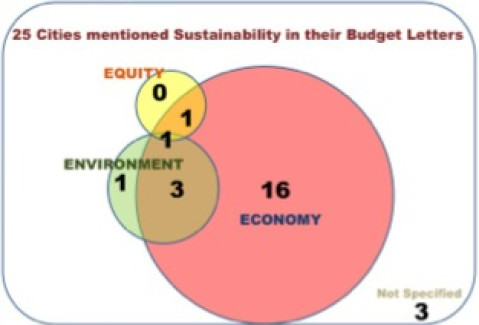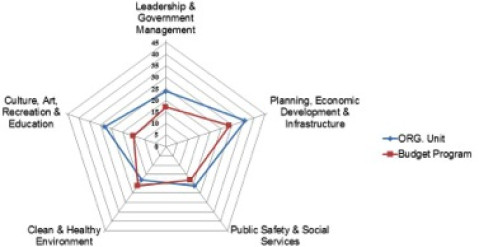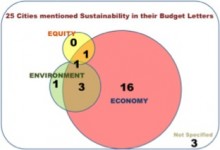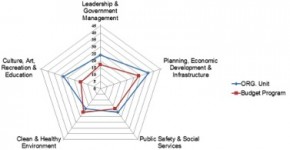Widgetized Section
Go to Admin » Appearance » Widgets » and move Gabfire Widget: Social into that MastheadOverlay zone
A Sketch of Sustainability in U.S. City Budgets
“Sustainability” is a buzzword in many fields across disciplines these days. Since sustainable development (SD) was proclaimed at the United Nations (UN) Conference on Environment and Development in Rio de Janeiro in 1992, this term rapidly spread throughout the world and became an important issue in academia as well as government in practice. In the U.S., SD has been promoted at the federal level for last 20 years. The Presidential Council on Sustainable Development (PCSD), established in 1993, published the final report Towards a Sustainable America in 1999, which recommended about 140 specific action plans that governmental organizations would be able to utilize for pursuing sustainability for American families and communities. In addition, the Obama administration recently promulgated Executive Order No. 13514 to make federal agencies include sustainability in their performance management system, and several federal grant programs were provided to promote sustainability in local authorities. However, the term sustainability is not always welcome in the U.S. At the state level, there are several states that legislated or are planning to legislate a bill against Agenda 21, which is a voluntary action plan for promoting SD by the UN. For example, the Republican National Committee passed a Resolution Exposing United Nations Agenda 21 on January 2013; House bill 1187 (2013) of Florida is “endorsing rejection of the United Nations’ Agenda 21;” and other states such as Alabama, Tennessee, Kansas, Georgia, Wisconsin, Texas, South Dakota, Arkansas and Nebraska follow.
The more controversy we have, the clearer understanding we need. However, the concept of sustainability is still vague and it thus usually has no meaning absent of context. In spite of the ambiguity per se, ‘sustainability’ is a frequently cited word by the leaders of local governments in these days. Although reference to sustainability has become more frequent, there is nevertheless a lack of research. Moreover, ambiguous usage of sustainability as a budget concept brought confusion to applying sustainability to the local budget practices. Therefore, I conducted a content analysis on the budget reports to provide a sketch of the current adoption of SD as a budget concept in U.S. cities by identifying how the budget message describes the concept of SD and investigates which units of the city government focus on sustainability, and provides performance goals and indicators for SD in their budget report. I gathered 51 sample cities whose population is greater than 300,000 and were awarded the “Distinguished Budget Presentation Award” from the Government Finance Officers Association at least one time during 2007-11. These criteria would guarantee the cities’ capacity for independent budgeting and financial management and the quality of the budget report.
In this research, I regard the concept of sustainable development, which is pursuing economic development, protecting the environment and securing social equity in the mean time, as a normative way of describing or understanding sustainability. Based on this assumption, I assume that a city will have balanced understanding if all aspects of sustainable development are mentioned in the budget message; partial understanding if only one or two aspects are mentioned, and no concern if sustainability is not mentioned al all. First, I searched for words that contain ‘sustain,’ the root word, in them and categorized each word according to if it refers to sustainability (or sustainable development) or not. If it does, I analyze which aspect of sustainability the word indicates. I then categorized the cities by which aspects of sustainability they included in their budget letter. Among 45 cities used in this analysis, 20 cities do not mention sustainability in their budget message. Among 25 cities that mentioned sustainability, their ways of understanding sustainability vary and are biased to economic aspects of sustainability. As figure 1 shows, there are 16 cities that mention only the economic development aspect while there is only one city that includes all aspects of sustainability in the budget message.
Figure 1 – Sustainability in Budget Messages
I conducted a similar content analysis on the departmental budget section to figure out which organizational unit or budget program include the root word ‘sustain’ in their performance budget system, which refers to mission statement, objective, performance goal and performance indicators. If the term was found, I investigated whether it means sustainability. I, if it is so, consider the organizational unit and budget program to have sustainability in their performance budget system. To analyze them, I categorize the roles of city government into five, and check if a category has at least one organizational unit or budget program that has sustainability in its performance system. Figure 2 shows the result of organizational unit and budget program analysis. The number of the spider web refers to the number of cities that contains sustainability in the category, and the blue indicate the result of organizational unit analysis, while red indicate the result of budget program analysis. For instance, there are more than 36 cities that have at least one organizational unit that has sustainability in their performance budgeting system in the category of Planning, Economic Development & Infrastructure and 25 cities that have at least one budget program containing sustainability in its performance budgeting system in the same category. Even if I used very loose criteria, the result shows the biased adaptation of sustainability in the performance budgeting system.
Figure 2 – Sustainability in the Performance Budget System by Roles of Government
In spite of many deficiencies of this empirical research, this study is contributory in several points. Theoretically, it raises a question about what sustainability U.S. cities are mentioning. Methodologically, it suggests applying qualitative research on the budget report. Practically, it provides a sketch of sustainability in the U.S. city governments. To overcome the limitations of this research, I am preparing a follow-up study utilizing a content analysis software package to provide a clearer understanding of the way in which U.S. cities understand sustainability in their budget letter. In addition, I am planning to use empirical research to investigate the influential factors on the understanding and the way of adopting sustainability in performance systems.
____________________________________________________________________
Author: Byungwoo(Shine) Cho is a first-year doctoral student at School of Public Administration, University of Nebraska at Omaha. His research interest is in the sustainable development initiatives in the U.S., and he is investigating the way in which city governments implement it at the managerial level.








Follow Us!